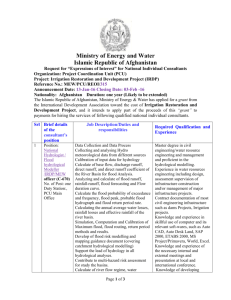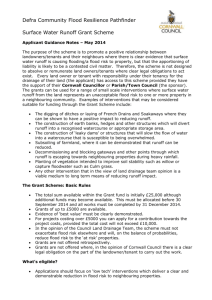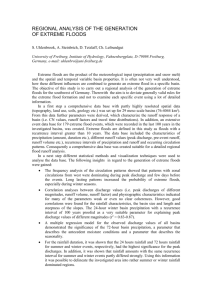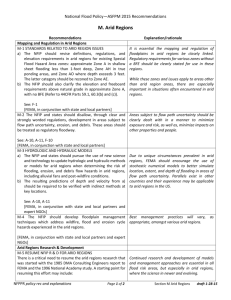Study of Suitable Methods for Runoff and Flood Estimating in
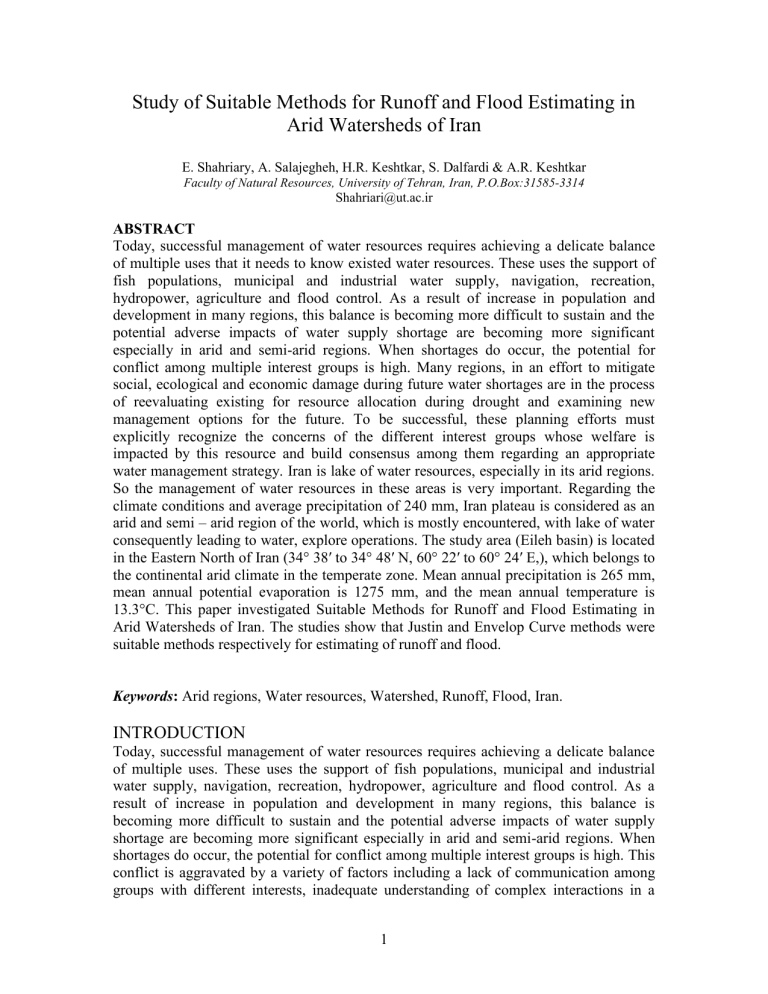
Study of Suitable Methods for Runoff and Flood Estimating in
Arid Watersheds of Iran
E. Shahriary, A. Salajegheh, H.R. Keshtkar, S. Dalfardi & A.R. Keshtkar
Faculty of Natural Resources, University of Tehran, Iran, P.O.Box:31585-3314
Shahriari@ut.ac.ir
ABSTRACT
Today, successful management of water resources requires achieving a delicate balance of multiple uses that it needs to know existed water resources. These uses the support of fish populations, municipal and industrial water supply, navigation, recreation, hydropower, agriculture and flood control. As a result of increase in population and development in many regions, this balance is becoming more difficult to sustain and the potential adverse impacts of water supply shortage are becoming more significant especially in arid and semi-arid regions. When shortages do occur, the potential for conflict among multiple interest groups is high. Many regions, in an effort to mitigate social, ecological and economic damage during future water shortages are in the process of reevaluating existing for resource allocation during drought and examining new management options for the future. To be successful, these planning efforts must explicitly recognize the concerns of the different interest groups whose welfare is impacted by this resource and build consensus among them regarding an appropriate water management strategy. Iran is lake of water resources, especially in its arid regions.
So the management of water resources in these areas is very important. Regarding the climate conditions and average precipitation of 240 mm, Iran plateau is considered as an arid and semi – arid region of the world, which is mostly encountered, with lake of water consequently leading to water, explore operations. The study area (Eileh basin) is located in the Eastern North of Iran (34° 38′ to 34° 48′ N, 60° 22′ to 60° 24′ E,), which belongs to the continental arid climate in the temperate zone. Mean annual precipitation is 265 mm, mean annual potential evaporation is 1275 mm, and the mean annual temperature is
13.3°C. This paper investigated Suitable Methods for Runoff and Flood Estimating in
Arid Watersheds of Iran. The studies show that Justin and Envelop Curve methods were suitable methods respectively for estimating of runoff and flood.
Keywords: Arid regions, Water resources, Watershed, Runoff, Flood, Iran.
INTRODUCTION
Today, successful management of water resources requires achieving a delicate balance of multiple uses. These uses the support of fish populations, municipal and industrial water supply, navigation, recreation, hydropower, agriculture and flood control. As a result of increase in population and development in many regions, this balance is becoming more difficult to sustain and the potential adverse impacts of water supply shortage are becoming more significant especially in arid and semi-arid regions. When shortages do occur, the potential for conflict among multiple interest groups is high. This conflict is aggravated by a variety of factors including a lack of communication among groups with different interests, inadequate understanding of complex interactions in a
1
water supply system, lack of common data agreement on assumptions, and inexperience with extreme or unusual events. Many regions, in an effort to mitigate social, ecological and economic damage during future water shortages are in the process of reevaluating existing for resource allocation during drought and examining new management options for the future. To be successful, these planning efforts must explicitly recognize the concerns of the different interest groups whose welfare is impacted by this resource and build consensus among them regarding an appropriate water management strategy
(Bingham 1989).
STUDY AREA
The study area (Eileh) is located in the Taibad Plain (34° 38′ 18” to 34° 48′ 32” N, 60°
22′ 17”to 60° 24′ 37”E,) in the Eastern-North of Iran, which belongs to the continental arid climate in the temperate zone. Mean annual precipitation is 265 mm, mean annual potential evaporation is 1275 mm, and the mean annual temperature is 13.3°C.
Fig.1. Study Area
2
Materials & Methods
Runoff
Eileh River is a seasonal river and located in Eastern-North of Iran that flows in wet months (February to April). Studies show surface water in Eileh river is very slight.
Runoff studies did using C.C.Vermuel, khoslu's, Justin and ICAR methods. We tried to select the best method by field control and analysis of total calculation.
Flood
Flood studies were done by Regional Analysis, Envelope curve, Mathematic and SCS
Methods. One of the approaches that we used for flood estimating was Envelope curve method that K coefficient modified by Jalali et al. (1996) for arid and semi-arid regions of
Iran.
RESULTS
High of runoff in year determined by C.C.Vermuel, khoslu's, Justin and ICAR methods and respectively were 15.6, 22.8, 5.11 and 4.41 cm.
Table1- Precipitation data of Eileh (mm)
Months
Precipitation
Sep. Oct. Nov. Dec. Jan. Feb. Mar. Apr. May Jun Jul. Ag.
0 1.56 10.2 25.7 33.9 50.9 59.1 48.6 18.4 2 0.34 0.13
Table2- Runoff Estimated by Justin and ICAR Methods
Basin Area(Km 2 ) Justin(cm) ICAR(cm) C1 V1(m.c.m.) C2 V2(m.c.m.)
Eileh 18.85 5.11 4.41 0.19 0.96 0.17 0.83
Table3- Runoff Estimated by C.C.Vermuel and khoslu's Methods
Basin
Annual
Precipitation
Average
(mm)
265
Annual
Temperature
Average 0 C
Runoff High
Average (cm)
C.C.Vermuel
Runoff High
Average (cm) khoslu's
Eileh 13.3 15.6 22.8
Flood studies were done by Regional Analysis, Envelope curve, Mathematic and SCS
Methods that shows in follow tables.
Basin
Eileh
Basin
Eileh
Table4- Flood Estimated by Regional Analysis Method in Eileh (m
3
/s)
Area (Km 2 )
18.85
2
14.8
2
28.8
Return Period (Year)
10
60
20
83.6
25
91.7
Table5- Flood Estimated by Envelope Curve Method in Eileh (m
3
/s)
50 100
118.8 148.5
Area (Km 2 )
18.85
2
7.3
2
13.1
Return Period (Year)
10 20 25
19.8 29.3 33.1
50
47.5
100
66
3
Basin
Eileh
Table6- Flood Estimated by Mathematic Method in Eileh (m
3
/s)
Area (Km 2 )
18.85
2
4.6
2
12.5
Return Period (Year)
10
23.8
20
33.7
25
38.7
50
58.7
100
86.9
Basin
Eileh
Table7- Flood Estimated by SCS Method in Eileh (m
3
/s)
Area (Km 2 )
18.85
2
15.6
2
26.5
Return Period (Year)
10 20 25
33.2 39.4 41.3
CONCLUSION
50
52
100
57.3
Regarding to climate, topography, vegetation and general conditions of watershed and studies and field control, we concluded that Justin is the best method for estimating runoff in this region. Because this method use effective factors on runoff such as slope percentage to estimating runoff. For flood estimating results showed that Envelop Curve method because apply modified K coefficient for arid and semi-arid regions of Iran was suitable method for flood estimation.
REFRENCES
Bingham, Gail and Suzanne G. Orenstein , 1989. The Role of Negotiation in Managing Water
Conflicts. Managing Water Conflicts: The Engineer’s Role, Proceeding of the Engineering
Foundation Conference. American Society of Civil Engineers, NY, 38-53.
Keshtkar A. R.
, 2004, “Investigation of Water Resources in Eileh” Watershed Management
Office, Report No: 4, pp.1-85.
4
